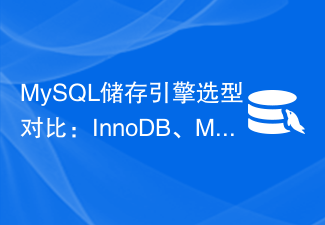In earlier InnoDB versions, since there was only one file format, there was no need to name this file format. As the InnoDB engine evolves, new file formats that are incompatible with earlier versions are developed to support new features. Today we will introduce the InnoDB row storage format.

The InnoDB storage engine supports four formats: REDUNDANT, COMPACT, DYNAMIC, and COMPRESSED.
InnoDB row format overview

##REDUNDANT row format
REDUNDANT format provides compatibility with older versions of MySQL. The REDUNDANT row format is supported by two InnoDB file formats (Antelope and Barracuda). Tables using the REDUNDANT row format store the first 768 bytes of variable-length column values (VARCHAR, VARBINARY, and BLOB and TEXT types) in index records within B-tree nodes, and the remainder in overflow page. Fixed-length columns greater than or equal to 768 bytes are encoded as variable-length columns and can be stored off-page. For example, a CHAR(255) column can exceed 768 bytes if the maximum byte length of the character set is greater than 3 utf8mb4. If the column's value is 768 bytes or less, overflow pages are not used and may result in some savings in I/O because the value is stored entirely in the B-tree node. This works fine for relatively short BLOB column values, but can cause B-tree nodes to be populated with data rather than key values, making them less efficient. Tables with many BLOB columns can cause B-tree nodes to become too full and contain too few rows, making the entire index less efficient than if the rows were shorter or the column values were stored off-page.REDUNDANT row format storage characteristics
REDUNDANT row format has the following storage characteristics:- Each index record contains a 6 Bytes header. Headers are used to link consecutive records together, and for row-level locking.
- Records in a clustered index contain fields for all user-defined columns. In addition, there is a 6-byte transaction ID field and a 7-byte rolling pointer field.
- If no primary key is defined for the table, each clustered index record also contains a 6-byte row ID field.
- Each secondary index record contains all primary key columns defined for the clustered index key that are not in the secondary index.
- Records contain pointers to each field of the record. If the total length of the fields in the record is less than 128 bytes, the pointer is one byte; otherwise, two bytes. The array of pointers is called the record directory. The area pointed to by the pointer is the data part of the record.
- Internally, fixed-length character columns such as CHAR(10) are stored in fixed-length format. Trailing spaces are not truncated from VARCHAR columns. Fixed-length columns greater than or equal to 768 bytes are encoded as variable-length columns and can be stored off-page. For example, a CHAR(255) column can exceed 768 bytes if the maximum byte length of the character set is greater than 3 utf8mb4.
- SQL NULL values retain one or two bytes in the record directory. NULL SQL values will retain zero bytes in the data portion of the record if stored in a variable-length column. For fixed-length columns, the fixed length of the column is retained in the data portion of the record. Reserving fixed space for NULL values allows columns to be updated from NULL to non-NULL values without causing index page fragmentation.
COMPACT row format
COMPACT row format reduces the number of rows by approximately 20% compared to REDUNDANT row format Storage space, REDUNDANT comes at the cost of increased CPU usage for certain operations. If your workload is typical and limited by cache hit ratio and disk speed, the COMPACT format may be faster. If the workload is limited by CPU speed, the compact format may be slower. COMPACT line format is supported by two InnoDB file formats (Antelope and Barracuda). Tables using the COMPACT row format store the first 768 bytes of variable-length column values (VARCHAR, VARBINARY, and BLOB and TEXT types) in index records within B-tree nodes, and the remainder in overflow page. Fixed-length columns greater than or equal to 768 bytes are encoded as variable-length columns and can be stored off-page. For example, CHAR(255) if the maximum byte length of the character set is greater than 3, can exceed 768 bytes if the column is a utf8mb4 character type. If the column's value is 768 bytes or less, overflow pages are not used and may result in some savings in I/O because the value is stored entirely in the B-tree node. This works fine for relatively short BLOB column values, but can cause B-tree nodes to be populated with data rather than key values, making them less efficient. Tables with many BLOB columns can cause B-tree nodes to become too full and contain too few rows, making the entire index less efficient than if the rows were shorter or the column values were stored off-page.COMPACT row format storage properties
COMPACT row format has the following storage characteristics:
Each index record contains a 5-byte header, which can be preceded by a variable-length header. Headers are used to link consecutive records together, and for row-level locking.
The variable-length portion of the record header contains a bit vector indicating a NULL column. If the number of columns in the index can be NULL , the bit vector occupies N bytes. (For example, if there can be anywhere from 9 to 16 columns, the bit vector uses two bytes.) Columns that do not occupy space beyond the bits in this vector. The variable-length portion of the header also contains the length of the variable-length column. Each length requires one or two bytes, depending on the maximum length of the column. If all columns in the index are CEILING(*N*/8)NULLNULLNOT NULL and have fixed length, the record header has no variable-length part.
For each non-NULL variable-length field, the record header contains one or two bytes of the column length. Only two bytes are required if part of the column is stored outside the overflow page, or if the maximum length exceeds 255 bytes and the actual length exceeds 127 bytes. For external storage columns, the 2-byte length represents the length of the internal storage section plus a 20-byte pointer to the external storage section. The inner part is 768 bytes, so the length is 768 20. The 20-byte pointer stores the true length of the column.
The record header is followed by the data content of the non-NULL column.
Records in a clustered index contain fields for all user-defined columns. In addition, there is a 6-byte transaction ID field and a 7-byte rolling pointer field.
If no primary key is defined for the table, each clustered index record also contains a 6-byte row ID field.
Each secondary index record contains all primary key columns defined for the clustered index key that are not in the secondary index. If any primary key columns are variable length, then each secondary index's record header has a variable-length section to record their length, even if secondary indexes are defined on fixed-length columns.
Internally, for non-variable-length character sets, a fixed-length character sequence (e.g. stored in CHAR(10) fixed-length format). Trailing spaces are not truncated from VARCHAR columns.
Internally, for variable-length character sets such as utf8mb3 and utf8mb4, InnoDB attempts to store bytes by trimming trailing spaces. If the column value exceeds bytes, trailing spaces are adjusted to the minimum length of the column value in bytes. The maximum length of a column is the maximum character byte length × CHAR(*N*)NCHAR(*N*)NCHAR(*N*)
N retains the minimum number of bytes. Reserving minimum space in many cases allows column updates to be completed without causing index page fragmentation. In contrast, when using row format, columns occupy a maximum character byte length × CHAR(*N*)NCHAR(*N*)NREDUNDANT
Fixed-length columns greater than or equal to 768 bytes are encoded It is a variable length field and can be stored off-page. For example, CHAR(255) if the maximum byte length of the character set is greater than 3, can exceed 768 bytes if the column is a utf8mb4 character type.
COMPACT row format storage characteristics diagram
MySQL InnoDB COMPAT row format structure


| Name| Size (bit) | Description| | ———— | ——— | ———————————————————— | | Reserved bit | 1 | Unknown | | Reserved bit | 1 | Unknown | | delete_flag | 1 | Whether the row has been deleted | | min_rec_flag | 1 | 1 if the record is predefined as the smallest record | | n_owned | 4 | The number of records owned by this record | | heap_no | 13 | The sorted record of this record in the index heap | | record_type | 3 | Record type, 000 means normal, 001 means B-tree node pointer, 010 means infimum, 011 means supermum, 1xx means reserved | | next_record | 16 | The relative position of the next record in the page

##DYNAMIC row format DYNAMIC The row format provides the same storage features as the COMPACT row format, but adds enhanced storage capabilities for long variable-length columns and support for large index key prefixes.
Barracuda file format supports DYNAMIC line format.
Create a table when using ROW_FORMAT=DYNAMIC. InnoDB can store long variable-length column values completely off-page (for VARCHAR, VARBINARY, BLOB and TEXT types). Clustered index records only contain 20 words pointing to the overflow page. section pointer. Fixed-length fields greater than or equal to 768 bytes are encoded as variable-length fields. For example, CHAR(255) if the maximum byte length of the character set is greater than 3, can exceed 768 bytes if the column is a utf8mb4 character type.
Whether a column is stored off-page depends on the page size and the total size of the rows. When a row is too long, the longest column is selected for off-page storage until the clustered index record fits on a B-tree page. TEXT and BLOB are columns less than or equal to 40 bytes that are stored on the line.
The DYNAMIC row format maintains the efficiency of storing the entire row in the index node where it fits (as done by the COMPACT and REDUNDANT formats), but the DYNAMIC row format avoids filling B-tree nodes with a large number of long column data bytes The problem. The DYNAMIC row format is based on the idea that if part of a long data value is stored off the page, it is usually most efficient to store the entire value off the page. For DYNAMIC format, shorter columns may be retained in B-tree nodes, minimizing the number of overflow pages required for a given row.
DYNAMIC row format supports index key prefixes up to 3072 bytes. This feature is controlled by the innodb_large_prefix variable, which is enabled by default. For more information about innodb_large_prefix, see variable description.
Tables using DYNAMIC row format can be stored in system table spaces, file-per-table table spaces and general table spaces. To DYNAMIC store a table in the system tablespace, disable innodb_file_per_table and use a regular CREATE TABLE or ALTER TABLE statement, or use the TABLESPACE [=] innodb_system table option with CREATE TABLE or ALTER TABLE. The innodb_file_per_table and innodb_file_format variables do not apply to general tablespaces, nor are they applicable when the TABLESPACE [=] innodb_system table option is used to store DYNAMIC tables in the system tablespace.
DYNAMIC row format storage properties
DYNAMIC row format is a deviation from the COMPACT row format.
COMPRESSED row format
COMPRESSED row format provides the same storage features and functionality as the DYNAMIC row format, but with the addition of table and index data Compression support.
Barracuda file format supports COMPRESSED line format.
COMPRESSED row format uses similar internal details off page storage as the DYNAMIC row format, from which additional storage and performance considerations for table and index data are compressed and use smaller page sizes. Using the COMPRESSED row format, the KEY_BLOCK_SIZE option controls how much column data is stored in the clustered index, and how much is placed on the overflow page.
COMPRESSED row format supports index key prefixes up to 3072 bytes. This feature is controlled by the innodb_large_prefix variable, which is enabled by default.
COMPRESSED Tables using row format can be created in a file tablespace or a general tablespace per table. The system tablespace does not support the COMPRESSED row format. To store COMPRESSED tables in a file-per-table tablespace, the innodb_file_per_table variable must be enabled, and innodb_file_format must be set to Barracuda. The innodb_file_per_table and innodb_file_format variables do not apply to general table spaces. General table spaces support all row formats, but it should be noted that due to different physical page sizes, compressed and uncompressed tables cannot coexist in the same general table space. See Section 14.6.3.3, “General Tablespaces” for more information.
COMPRESSED row format storage properties
COMPRESSED row format is a deviation from the COMPACT row format. It's just that there is a little difference when dealing with row overflow data. The first 768 bytes of the string will not be stored at the real data recorded. Instead, all bytes will be stored in other pages, only at the real data recorded. The addresses of other pages are stored here. In addition, the Compressed row format will use a compression algorithm to compress the page.
Related recommendations: "mysql tutorial"
The above is the detailed content of What is InnoDB row storage format. For more information, please follow other related articles on the PHP Chinese website!
 MySQL如何从二进制内容看InnoDB行格式Jun 03, 2023 am 09:55 AM
MySQL如何从二进制内容看InnoDB行格式Jun 03, 2023 am 09:55 AMInnoDB是一个将表中的数据存储到磁盘上的存储引擎,所以即使关机后重启我们的数据还是存在的。而真正处理数据的过程是发生在内存中的,所以需要把磁盘中的数据加载到内存中,如果是处理写入或修改请求的话,还需要把内存中的内容刷新到磁盘上。而我们知道读写磁盘的速度非常慢,和内存读写差了几个数量级,所以当我们想从表中获取某些记录时,InnoDB存储引擎需要一条一条的把记录从磁盘上读出来么?InnoDB采取的方式是:将数据划分为若干个页,以页作为磁盘和内存之间交互的基本单位,InnoDB中页的大小一般为16
 mysql innodb是什么Apr 14, 2023 am 10:19 AM
mysql innodb是什么Apr 14, 2023 am 10:19 AMInnoDB是MySQL的数据库引擎之一,现为MySQL的默认存储引擎,为MySQL AB发布binary的标准之一;InnoDB采用双轨制授权,一个是GPL授权,另一个是专有软件授权。InnoDB是事务型数据库的首选引擎,支持事务安全表(ACID);InnoDB支持行级锁,行级锁可以最大程度的支持并发,行级锁是由存储引擎层实现的。
 Mysql中的innoDB怎么解决幻读May 27, 2023 pm 03:34 PM
Mysql中的innoDB怎么解决幻读May 27, 2023 pm 03:34 PM1.Mysql的事务隔离级别这四种隔离级别,当存在多个事务并发冲突的时候,可能会出现脏读,不可重复读,幻读的一些问题,而innoDB在可重复读隔离级别模式下解决了幻读的一个问题,2.什么是幻读幻读是指在同一个事务中,前后两次查询相同范围的时候得到的结果不一致如图,第一个事务里面,我们执行一个范围查询,这个时候满足条件的数据只有一条,而在第二个事务里面,它插入一行数据并且进行了提交,接着第一个事务再去查询的时候,得到的结果比第一次查询的结果多出来一条数据,注意第一个事务的第一次和第二次查询,都在同
 mysql innodb异常怎么处理Apr 17, 2023 pm 09:01 PM
mysql innodb异常怎么处理Apr 17, 2023 pm 09:01 PM一、回退重新装mysql为避免再从其他地方导入这个数据的麻烦,先对当前库的数据库文件做了个备份(/var/lib/mysql/位置)。接下来将Perconaserver5.7包进行了卸载,重新安装原先老的5.1.71的包,启动mysql服务,提示Unknown/unsupportedtabletype:innodb,无法正常启动。11050912:04:27InnoDB:Initializingbufferpool,size=384.0M11050912:04:27InnoDB:Complete
 MySQL储存引擎选型对比:InnoDB、MyISAM与Memory性能指标评估Jul 26, 2023 am 11:25 AM
MySQL储存引擎选型对比:InnoDB、MyISAM与Memory性能指标评估Jul 26, 2023 am 11:25 AMMySQL储存引擎选型对比:InnoDB、MyISAM与Memory性能指标评估引言:在MySQL数据库中,储存引擎的选择对于系统性能和数据完整性起着至关重要的作用。MySQL提供了多种储存引擎,其中最常用的引擎包括InnoDB、MyISAM和Memory。本文将就这三种储存引擎进行性能指标评估,并通过代码示例进行比较。一、InnoDB引擎InnoDB是My
 如何使用MyISAM和InnoDB存储引擎来优化MySQL性能May 11, 2023 pm 06:51 PM
如何使用MyISAM和InnoDB存储引擎来优化MySQL性能May 11, 2023 pm 06:51 PMMySQL是一款广泛使用的数据库管理系统,不同的存储引擎对数据库性能有不同的影响。MyISAM和InnoDB是MySQL中最常用的两种存储引擎,它们的特点各有不同,使用不当可能会影响数据库的性能。本文将介绍如何使用这两种存储引擎来优化MySQL性能。一、MyISAM存储引擎MyISAM是MySQL最常用的存储引擎,它的优点是速度快,存储占用空间小。MyISA
 提高MySQL存储引擎读取性能的技巧和策略:MyISAM与InnoDB对比分析Jul 26, 2023 am 10:01 AM
提高MySQL存储引擎读取性能的技巧和策略:MyISAM与InnoDB对比分析Jul 26, 2023 am 10:01 AM提高MySQL存储引擎读取性能的技巧和策略:MyISAM与InnoDB对比分析引言:MySQL是最常用的开源关系型数据库管理系统之一,主要用于存储和管理大量结构化数据。在应用中,对于数据库的读取性能往往是非常重要的,因为读取操作是大部分应用的主要操作类型。本文将重点讨论如何提高MySQL存储引擎的读取性能,重点对比分析MyISAM和InnoDB这两个常用的存
 支持GIS数据的MySQL存储引擎:InnoDB中的空间索引优化Jul 24, 2023 pm 11:07 PM
支持GIS数据的MySQL存储引擎:InnoDB中的空间索引优化Jul 24, 2023 pm 11:07 PM支持GIS数据的MySQL存储引擎:InnoDB中的空间索引优化摘要:在现代的数据库应用中,地理信息系统(GIS)数据扮演着越来越重要的角色。GIS数据处理是复杂和动态的,传统的关系型数据库并不擅长处理这种类型的数据。然而,MySQL提供了一种存储引擎,即InnoDB,可以优化GIS数据的处理。本文将介绍如何在InnoDB存储引擎上使用空间索引来优化GIS数


Hot AI Tools

Undresser.AI Undress
AI-powered app for creating realistic nude photos

AI Clothes Remover
Online AI tool for removing clothes from photos.

Undress AI Tool
Undress images for free

Clothoff.io
AI clothes remover

AI Hentai Generator
Generate AI Hentai for free.

Hot Article

Hot Tools

SublimeText3 Mac version
God-level code editing software (SublimeText3)

SublimeText3 Linux new version
SublimeText3 Linux latest version

SecLists
SecLists is the ultimate security tester's companion. It is a collection of various types of lists that are frequently used during security assessments, all in one place. SecLists helps make security testing more efficient and productive by conveniently providing all the lists a security tester might need. List types include usernames, passwords, URLs, fuzzing payloads, sensitive data patterns, web shells, and more. The tester can simply pull this repository onto a new test machine and he will have access to every type of list he needs.

WebStorm Mac version
Useful JavaScript development tools

SublimeText3 English version
Recommended: Win version, supports code prompts!






